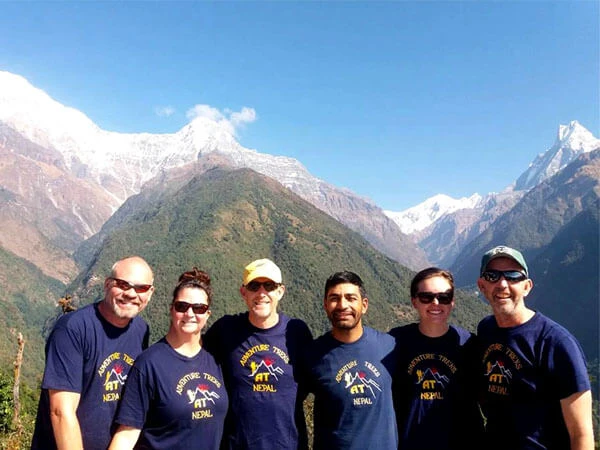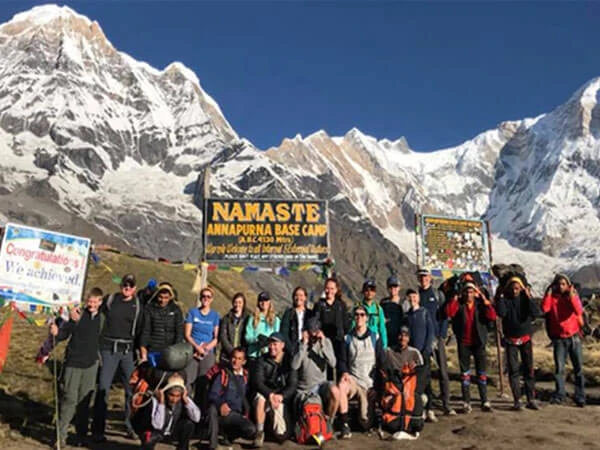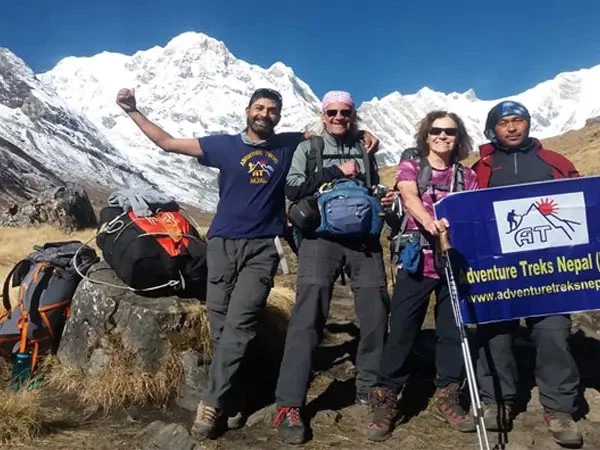Why is Nepal Trekking Timing Important?
Trekkers love to face any kind of situation that occurs while they are on a trip. However, unpredictable weather in the Himalayan region of Nepal may produce more obstacles and distract you from completing your dream journey. To avoid all these states of affairs, you should choose the best trekking seasons in Nepal.
Especially, it’s crucial to choose the best time to trek in the Himalayas to encounter panoramic vistas of majestic mountains. It' 's challenging to hike in high altitudes with worse weather and you should ensure safety and have a thrilling experience without panic situations.
Due to many difficulties—slick paths, bitter cold—once the monsoon or winter is up, trekking would also require careful planning. Choosing an ideal time for your journey improves comfort and increases safety, including the opportunity to take in most of the different scenery and cultural variations of Nepal.

The Best Trekking Seasons in Nepal
Spring Trekking Season: The Blooming Paradise
Who wouldn't want to spend some of the most precious time surrounded by beautiful flowers, bright skies, and mild weather? Indeed, it is one of the best times of year to go trekking in Nepal, especially for individuals who have never gone trekking before. With temperatures ranging from 10 to 20 °C (50 to 68 °F), this season runs from October to February. The expedition will be rewarded with vistas of snow-capped mountains under a clear blue sky.
Regarding numerous fascinating trekking destinations, one can come across the best treks, like the Annapurna Base Camp Trek and Ghorepani Poonhill Trek, during this season. Autumn is crowded compared to the spring season, though they both have their benefits. Spring comes with the adventure of walking through rhododendron forests and seeing wildlife. This time is, however, calm and safe, preventing conditions such as extremely low temperatures or very much rain.

Autumn Trekking Season (September to November): The Golden Season
Autumn is the ideal time of year for trekkers who like to participate in festive endurance in Nepal, where the weather is consistent and the views of the massive mountains are clear. An odyssey is ideal during the season when national festivities like Dashain, Tihar, Chhath, etc. fall. The autumn trekking season is the best time to plan some of the greatest Nepal treks for novices. Autumn in Nepal offers exciting hiking and climbing conditions, heart-pounding landscapes, and moderate temperatures between 5 and 15°C (41 and 59°F) with a lower chance of cold than winter.
You must emotionally and physically prepare for your trek if you start it soon because monsoon problems can still arise. By mid-September, the weather stabilizes and is suitable for trekking. Enjoyment is possible without experiencing such a panic attack. You can start your Everest Base Camp, Annapurna Circuit, or Mardi Himal treksduring this period of the year.
Winter Season (December to February): A Quiet Challenge
Every trekker loves striking snow-clad mountain views and quiet trails, absorbing nature’s charm and leaving hectic city life behind. If you are ready to face the cold of winter, then you can make it, especially in low-altitude landscapes. During the winter season, the daytime temperatures range from 9°C to 12°C, while nighttime lows are below freezing.
Winter treks in Nepal may present the most travelers with a terrible experience. If you want to avoid crowds and tolerate such a situation, then you can go trekking. For instance, the Everest region is far less famous than it is in the autumn. However, high mountain passes such as Kongma La, Cho La, and Renjo La in the Everest region are typically closed from November to March due to morning fog. Some winter treks in Nepal are Ghorepani Poon Hill, Langtang Valley, and the Annapurna Sanctuary.

Monsoon Season (June to August): A Unique Experience
Monsoon season is for a trekker who loves to walk on less-crowded trails and observe a green environment. The season begins from late May to mid-September and brings with it hot, muggy weather that would create difficulty while ascending. Due to more rain in this period, leeches tend to soak the lower elevations. If you are ready to face challenges, you should prepare properly for slippery trails with essential rain gear for monsoon trekking in Nepal.
However, you can enjoy panoramic views of mountains and lush woodlands and get discount rates on trekking packages. For novice trekkers, it’s appropriate to focus on rain-shadow popular trekking destinations in Nepal, such as Upper Mustang and Dolpo. However, you need more caution while walking on steep trails.
Beginner-Friendly Routes for Each Season
Spring
The Ghorepani Poon Hill Trek is an ideal excursion that has become one of the best Nepal Treks for Beginners during the spring trekking season. It’s a short trek through Nepal’s wonderful and adventurous Annapurna region that can be completed within 4 to 5 days. You get the opportunity to explore the culture and traditions of the Magar and Gurung communities. Sunrise over Annapurna and Dhaula Giri from Poon Hill makes the odyssey worthwhile. On the other hand, hiking through dense forest, decorated with blooming rhododendrons, will be a once-in-a-lifetime experience.

Autumn
Autumn is the best time for trekking in Nepal for both beginners and experienced trekkers. The Annapurna Circuit Trekis one of the finest Nepal treks for beginners due to its easy trails, magnificent attractions, and stable weather during this autumn trekking season. The pristine skies with views of breathtakingly beautiful peaks such as Annapurna, Manaslu, and Dhaulagiri promise a perfect Himalayan trekking experience for novice trekkers. Enjoy typical Himalayan cuisine and local hospitality while exploring the different cultures of the Himalayas, specifically that of the Gurung and Thakali peoples. The trip is easy for beginners since it offers a scenic environment and pleasant temperatures.
Winter
The winter is challenging for trekking; daytime highs range from 9 to 12 degrees Celsius, while nighttime lows are below freezing. Trekkers who like risks can complete the Khumbu region's treks with the right gear and a qualified guide. But since there are other starting sites in the lower Everest region with the comforts of seeing some of the world's finest peaks, such as Mt. Everest (8848 m), Ama Dablam, etc., novices can also have the same experience. Inexperienced hikers can take advantage of the winter's less busy trails, stunning Sherpa homes, and dense forests with diverse wildlife and plants. You find several welcoming hotels in the lower Everest regions where visitors enjoy local cuisine.
Monsoon
Beginners encounter extra challenges during the monsoon season because of the slick trails caused by the intense rain. Novice hikers can venture into Nepal's rain-shadowed regions, such as Upper Mustang and Dolpo, which are protected from precipitation. You are rewarded with breathtaking views of beautiful mountains, thick wildflower woods, tumbling waterfalls, meandering rivers, and other typical distant settlements, even though the temperature is higher than in other seasons. Travelers can also take advantage of package savings during this time. In the Himalayan region, one should be prepared for unexpected weather, despite the decreased likelihood of rainfall.

Packing Tips For first-timers
As a beginner, you may be unable to prepare properly while planning the first trek in Nepal. If you miss anything essential in trekking gear, you can’t handle all situations that take place during the trek. In the Himalayan region, weather is unpredictable; you should pack crucial equipment to handle obstacles such as rainfall, snowfall, chilly winds, and walking on steep paths. Here are some tips for popular trekking destinations in Nepal, according to different trekking seasons.
Spring/Autumn :
Layers: Dress in layers, such as a fleece jacket, a warm, thick shirt, and a light shirt.
Jackets: Pack a waterproof jacket, a shell jacket, and a down jacket.
Pants: Pack cotton pants, hiking shorts, and windproof or waterproof pants.
Gloves: Pack woolen gloves, windproof or waterproof gloves, and lightweight gloves.
Hat: Pack an insulated hat, woolen hat, beanie, sunblock hat, or sunbrim.
Neck warmer: Pack a scarf, cowl, or neck warmer.
Trekking Boots: waterproof, breathable, lightweight
Trekking Shoes: Suitable for dry trails with moderate challenges
Gaiters: optional but useful for muddy or wet situations
Spare socks: Carry extra to keep your feet dry.
Other gear: umbrella, trash bags, camera, binoculars, compass or GPS, phone charger and power banks, reusable water bottles, sleeping Bags, sleeping mats, headlamps, sunglasses, trekking poles, ice axes, crampons,
Winter Season
Base Layers (Inner Layer): Thermal tops and bottoms that move moisture away from the skin (can be synthetic or pure wool, especially Merino).
Insulation Layer (Middle Layer): trekking pants insulated with fleece, insulated pants, down or fleece jackets for maintaining warmth.
Windproof/breathable material: Gore-Tex or an equivalent or a functional wind or soft-shell jacket with matching Gore-Tex or similar pants for the outer shell.
Hat/Beanie: To protect the head, the hood part of the hat is made of wool or fleece.
Neck/Balaclava Gaiter: Protects your neck and face from cold winds during the winter season.
Gloves: Base layers: moisture-wicking, lightweight gloves; outer layers: waterproof, insulated mittens or gloves.
Socks: wool or thermal socks
Jacket: Extremely warm down jacket for severe low temperatures, lightweight, and portable.
Winter hiking footwear: rubber-insulated, waterproof, and high-traction ice path boots
Gaiters: Protect your lower legs and your boots from the snow.
Microspikes or crampons: to have a better grip on the slippery, icy road or any terrain that has that sort of surface.
Backpack: See to it that it has a waterproof cover.
Sleeping Bag: Recommended for use where the temperature dips near or below the freezing point. The best accessories are bags made from down or synthetic materials.
Sleeping Mats: Make the gadget insulating to avoid the effect of a cold surface on the mat.
Other gear: trekking poles, headlamps, sunglasses, thermos, waterproof map, GPS, ice axes, snacks, and energy bars; first aid kit, insect repellent and sunscreen; plastic bags; and hand warmers.
Monsoon Season
Rain Jacket/Poncho: Water-proof, breathable material like Gore-Tex
Quick-Dry Clothing: Lightweight, moisture-wicking shirts and pants
Rain pants: waterproof, lightweight, and breathable pants.
Base Layers: Thermal or moisture-wicking base layers for warmth
Gaiters: Waterproof gaiters to keep your shoes and lower legs dry
Wide-brimmed Hat/Cap: For protection against rain and occasional sun
Waterproof trekking boots: Ensure good grip on muddy trails.
Sandals or Water Shoes: For River Crossing or Camp Use
Moisture-wicking socks: Wool or synthetic socks to keep your feet dry
Extra Pairs of Socks: Quick-drying or waterproof varieties
Other gear: waterproof backpack cover, dry bags or plastic liners, waterproof tent, waterproof sleeping bag, sleeping mat, umbrella, tarp or ground sheet, trekking poles, a headlamp with extra batteries, insect repellent (protection against mosquitoes and leeches), first aid kit, snacks and hydration, waterproof maps or GPS device, garbage bags, and Leeh socks.
Practical Tips for First-Time Trekkers
If you are a first-time trekker in Nepal, you should know an appropriate trekking route to do. Depending on what kind of trekker you are, then you should tread carefully on the trek because of the diverse terrains of Nepal and for some areas, unpredictable weather. Here are some helpful pointers for you:
- You should decide on the proper trek you wish to take: Ghorepani Poon Hill or Langtang Valley—one of the other well-known treks in Nepal that is easier/more intermediate.
- If one has a very crowded rucksack, then it becomes a tall order to tread the off-track path, which is why the backpack’s load should not be more than 10 to 12 kg.
- To be safe from altitude illness and enhance your water intake, you must consume adequate fluids but no alcohol.
- Adorn yourself with appropriate clothes depending on the ever-changing weather.
- The next step is to take a break and get ready to get acclimatized before going to a higher altitude.
- You should ensure you have cash with you, as many of these use ATMs since there are few, especially while trekking.
- The simple greetings of the people that live in that area should be learned, as well as their customs and cultural beliefs should be followed.
- Before trekking, one must be psychologically and physically dominated. Try to consume healthy meals to enhance your body's energy and do cardiovascular exercises like hiking, running, swimming, jumping, and many others.
- Make sure that the travel insurance policy you are to enroll in will cover the helicopter evacuation while trekking.
- Due to the change of weather, it is advisable to start early in the morning to fix the right tea houses for proper accommodation.

Conclusion
There is no off-season with regards to trekking in Nepal but depending on the type of trekking done with appropriate clothes and shoes, the right trek for the correct season comes with unique features in addition to the natural facts and some difficulties.
If you love to watch the wildflowers in bloom in spring, the clear blue sky of the autumn, or the silence of the winter, then there is a trek just right for you. The decision to go, the right packing, and the jump into the experience—the trekking trails in Nepal provide some of the most amazing experiences that will last a lifetime. You can even take advantage of off-season trekking advantages in Nepal.
Do you want to feel such unparalleled experiences? Then hurry up; we are here at Adventure Treks Nepal to assist you with every inquiry and make your dream trek at the best price with a licensed holder and well-trained trekking guide. As a novice trekker, you can embark on trekking such as Annapurna Base Camp Trek, Langtang Valley Trek, Ghorepani Poon Hill Trek, etc













